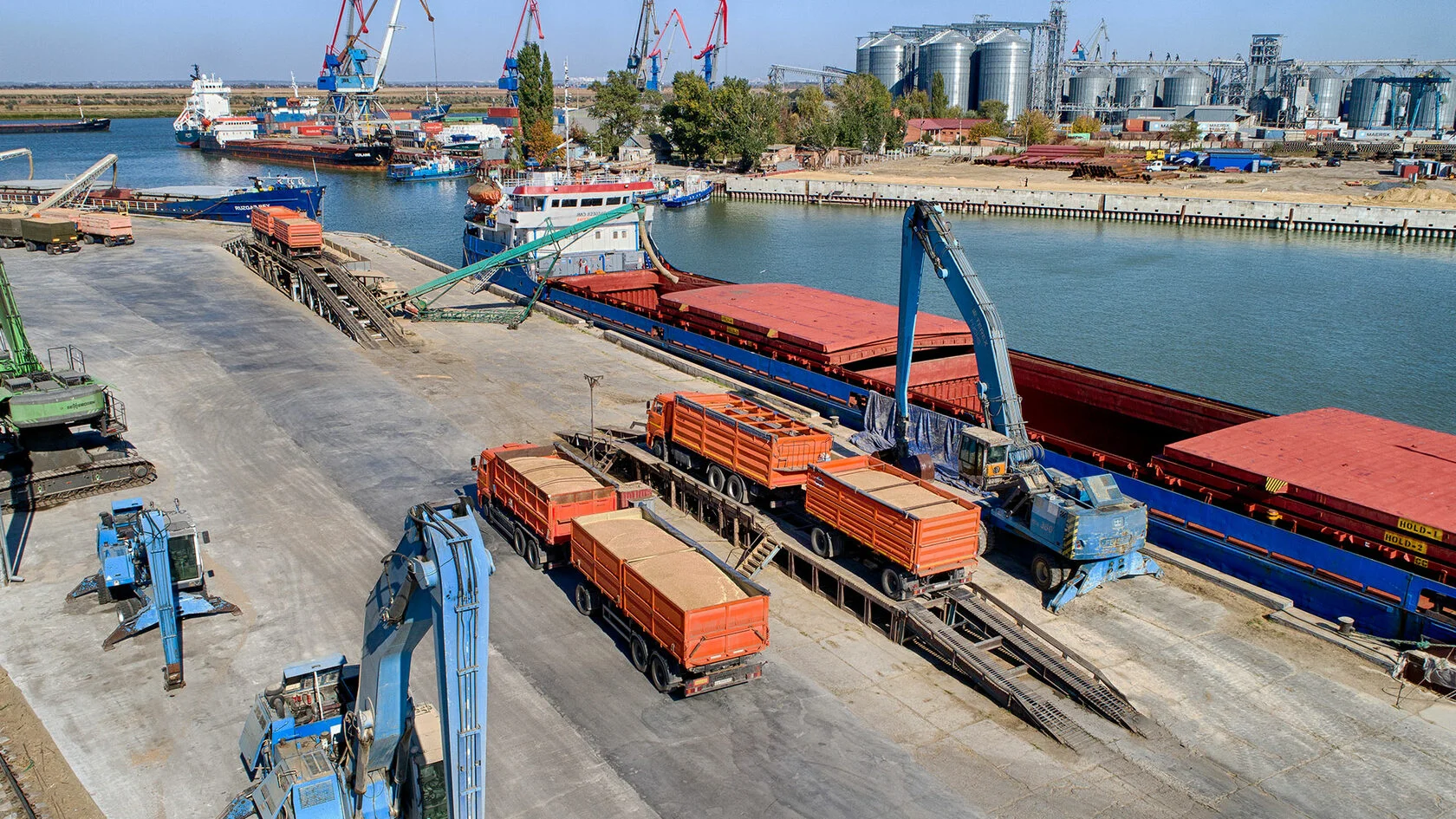
South Sea Port at Azov is a major export terminal for grain grown in Russia’s Rostov region. File photo: Astra Alliance
THE WINTER-CROP harvest has commenced in southern Russia, with progress slow and early yields disappointing relative to last season’s drought-reduced crop. However, local market analysts last week revised upward harvest forecasts, confident the production outlook will improve as the harvest progresses.
In Rostov, the country’s largest grain-producing region, early wheat yields are being reported at around 2 tonnes per hectare compared to an average of 3.6t/ha last year. In Krasnodar, another of the country’s major grain-producing regions, initial wheat yields of 4.5t/ha are being reported against an average of 6.2t/ha in 2024.
Krasnodar Rostov remain hopeful
With around 80 percent of Krasnodar’s barley harvest completed as of July 2, the average yield has improved from less than 5t/ha at the beginning of the campaign to around 5.75t/ha last week. This compares to a final average of just over 7.3t/ha last year. The poor yields to date are reportedly from the worst paddocks, as they were the earliest to mature and therefore the first to be harvested.
Black Sea grain consultancy SovEcon said that “initial yields in Krasnodar and Rostov are significantly below last year’s levels due to a moisture deficit. In contrast, soil-moisture reserves in Stavropol are above normal. Eventually, we expect some improvement in yields as the harvest moves on to less affected fields.”
Early last month, an agricultural emergency was declared for some parts of the Rostov region due to severe drought and spring frosts. More than 500,000ha of crop have reportedly been lost across nearly half of the region, with 19 of Rostov’s 43 districts currently under the emergency regime. A week later, the governor of the Krasnodar region followed suit by declaring its own state of agricultural emergency in eight drought-hit municipalities.
Such declarations allow affected farmers to apply for compensation, and presented a clear market signal that harvest yields would be adversely affected when headers started to roll. When making the announcement, the governor of Russia’s southern Krasnodar region, Veniamin Kondratiev, said, “this will make it possible to promptly provide targeted support to drought-affected enterprises and preserve the economy and labour collectives”.
Stavropol shines
On the other hand, crop conditions observed during recent crop tours around the Stavropol Territory suggest it could be the leading wheat-production region in Russia for the first time in many years, according to Russia’s Institute for Agricultural Market Studies (IKAR). Early harvest reports indicate wheat yields are running at 4 t/ha, well above last year’s average of 3.5t/ha.
Late last week, IKAR increased its national wheat production estimate from 84.5 million tonnes (Mt) to 85.2Mt, citing favourable weather conditions across the European regions of Russia during the critical winter wheat-filling and spring wheat-tillering crop stages. Additionally, the eastern reaches of the wheatbelt have continued to benefit from regular precipitation.
Spring crop regions mixed
However, the higher production forecast comes despite the smallest area planted to spring wheat since records began in 1970. IKAR believe the area may be down by as much as 5.7pc year-on-year to 11.6Mha, with the most pronounced decreases observed in Siberia, 700,000ha lower than last year, and in the Urals, down 300,000ha compared to 2024.
IKAR chief executive officer Dmitry Rylko stated that “this will be the lowest figure on record. It’s no coincidence, as we’re seeing severe disappointment with cultivating this crop in Western Siberia, the Urals, the Volga region and even other areas. The same applies to spring barley. Most likely, the planted area under barley will also hit its lowest since 1970. Moreover, the farther regions are from the Black Sea export market, the steeper the decline in the planted area.”
According to Mr Rylko, farmers in these spring-crop regions are increasingly focused on oilseed and pulse crops, primarily rapeseed, sunflower, chickpea, and lentils. He attributes the trend to the growth in exports of such commodities to China, and the remoteness of the regions relative to the large Black Sea ports.
SovEcon’s wheat production estimate also received a small boost late last month, increasing from 82.8Mt in early June to 83Mt, 600,000t higher than the final 2024 total of 82.4Mt. The revision reflects improved crop conditions in parts of central Russia, especially in the eastern areas and Voronezh. The improved outlook for the central region was partly offset by lower forecasts for Siberia and the Urals due to the sharp decrease in plantings.
The total grain crop forecast from SovEcon was also raised to 129.5Mt, 1.9Mt higher than the June projection of 127.6Mt. The barley output estimate was increased from 17.4Mt to 17.6Mt, while the corn projection was reduced from 14.6Mt to 14.3Mt due to a smaller planted area.
Official all grains total 135Mt
The Russian Ministry of Agriculture also reiterated its production forecast last week, maintaining a total grain harvest of 135Mt, including 90Mt wheat. This is up from the government’s 2024 total of 125.9Mt, which included 82.6Mt wheat. However, with private forecasters already factoring yield improvement into their revised forecasts, the significant void between official optimism and harvest reality certainly demands scrutiny in coming weeks as headers roll into those regions less impacted by the enduring soil-moisture deficits and severe spring frosts.
End to export tax
Meanwhile, the Russian Ministry of Agriculture has surprisingly decided to end its wheat export tax for the first time since the levy was introduced in 2021. Announced late Friday, the change is set to take effect on July 9, marking a significant shift in Moscow’s approach to balancing domestic supply and export competitiveness.
The export tax, designed initially to stabilise domestic food prices by preventing excessive overseas shipments, has been a constant source of friction between the government and Russian grain producers. With harvest underway and geopolitical tensions still influencing global commodity markets, Russia’s latest policy shift is likely to have a significant impact on international grain trade dynamics in the second half of 2025.

HAVE YOUR SAY